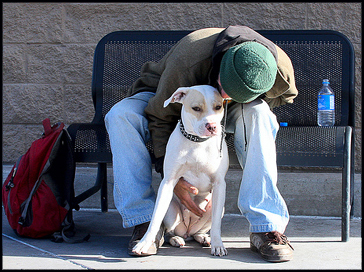
How often do you see a great review of a great movie? Joanne Laurier has written extensively about film, bringing to the task more intelligence and wisdom than most of her fellow critics.
For the World Socialist Web Site, she wrote about “an honest picture of American life,” the indie film titled Wendy and Lucy. It’s about a young woman experiencing homelessness with only her dog for company, and it will break your heart.
Wendy and Lucy was directed by Kelly Reichardt, who wrote it with Jonathan Raymond. It reflects today’s reality even more than the situation in 2008, the year of its release. We don’t learn a whole lot of Wendy’s backstory. Apparently, she was staying with her sister and brother-in-law before she hit the road, heading for Alaska, to try for a fish-cannery job. But then her car dies in Oregon.
While shoplifting some food for Lucy — and you can tell it’s not something she enjoys at all — Wendy gets caught and is taken away to be fingerprinted, and so on. When she gets back, Lucy is gone.
It turns out that the car would just plain cost too much to fix. Now Wendy is no longer even a rubber tramp, just a close-to-the-bottom-rung homeless person, carrying all her stuff around. And guess what — no booze, no dope, no psychosis. This woman wants to be a productive citizen and make a living wage. She was willing to drive all the way to Alaska to do that. Wendy is just a regular person who can’t catch a break.
The film set out to portray the growing chasm between the upper and lower classes in America. Laurier repeats and discusses some of the things that were said by writer-director Kelly Reichardt in an interview with the Providence Phoenix:
Reichardt notes that the film was intended to test out the notion that all one needs to succeed in America is ‘gumption.’ She continues, ‘Is that all you need, if you don’t have the benefit of an education or a social net or a financial net or health insurance or anything? I think that that’s implied all the time, and I think that’s a farce.’
Wendy often hums, as if there is a soundtrack of celestial music always playing in her head, and sometimes it leaks out. She searches in vain for Lucy. Without shelter and terribly vulnerable, Wendy is victimized. But that’s not the worst thing. The worst thing is, her companion is still gone.
Finally, Wendy locates the dog fenced into a backyard, and recognizes that it’s a good home. Knowing she will be hopping freights or worse, Wendy does not bust Lucy out. Like so many fathers, mothers, and lovers confronting the brutal imperatives of economics have done, Wendy makes the hard decision. She leaves Lucy there, promising, “When I make some money, I’ll come back.”
Separating from a pet is a terrible decision to be faced with. A while back, we talked about Becky Blanton, who had experienced homelessness. When she inadvertently ended up living in her van, she couldn’t afford to rent an apartment that demanded security deposits for her cat and dog, and wouldn’t give them up, so she remained in the van.
The good folks who run Pets of the Homeless tell us that about 10% of the homeless have pets, which generally makes their situation more problematic:
Most people who experience homelessness are homeless for a short period of time, and need help finding housing or a rent subsidy. Unfortunately for those with pets it becomes more difficult.
The nonprofit organization, which extends across the U.S. and Canada, helps with food and vet bills. They would love to teach you how to start a pet food pantry in your town!
Reactions?
Source: “Wendy and Lucy: A picture of American life,” WSWS.org, 02/20/09
Source: “What We Do,” PetsoftheHomeless.org
Image by Beverly & Pack, used under its Creative Commons license.
